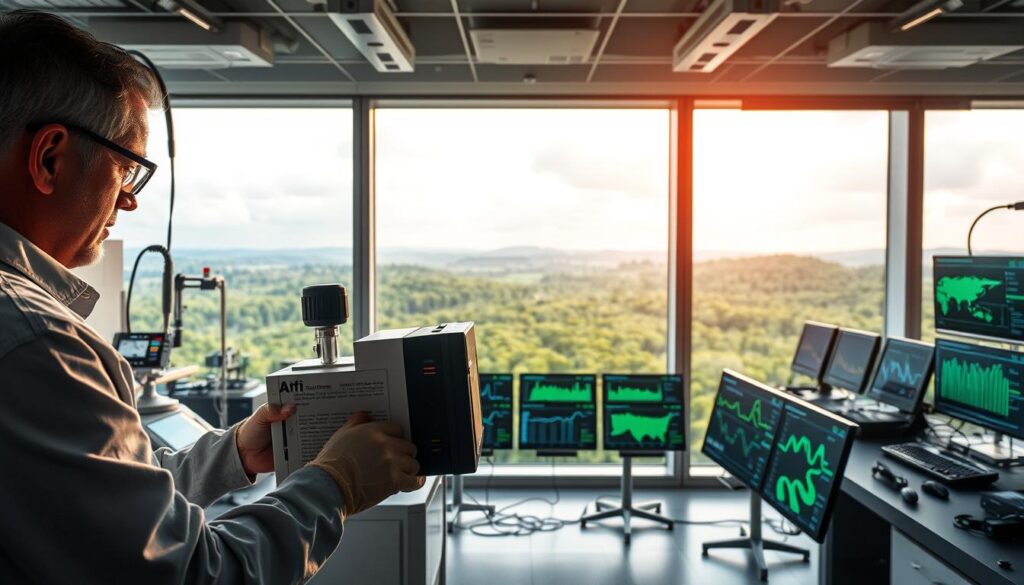Can advanced environmental data collection techniques revolutionize the field of environmental engineering?
As an environmental engineer, staying ahead of the curve is crucial for career advancement and making a meaningful impact. Mastering environmental monitoring engineering is essential for enhancing skills and staying current with the latest technologies and regulatory requirements.
The ability to collect and analyze environmental data effectively is at the heart of this discipline. By doing so, professionals can better understand and mitigate the impact of human activities on the environment.
Key Takeaways
- Understanding the principles of environmental monitoring engineering.
- The importance of accurate environmental data collection.
- Techniques for effective data analysis.
- Staying updated with the latest technologies and regulatory requirements.
- Career advancement through mastery of environmental monitoring engineering.
Introduction to Environmental Monitoring Engineering
As the world grapples with environmental challenges, the role of environmental monitoring engineering becomes increasingly vital. Environmental monitoring engineering involves the use of various techniques and technologies to monitor and manage environmental pollutants. This field has seen significant advancements, particularly with the integration of sophisticated environmental monitoring systems and sensor technology.
Definition and Importance
Environmental monitoring engineering is defined as the application of engineering principles to monitor, assess, and mitigate the impact of human activities on the environment. It is crucial for identifying pollution sources, understanding environmental changes, and developing strategies for sustainable development. The importance of this field lies in its ability to provide accurate and timely data, enabling policymakers and stakeholders to make informed decisions. Continuing education is essential for environmental engineers to enhance their skills, stay current with the latest technologies and regulatory requirements, and improve their career prospects, much like in other specialized fields such as transportation network engineering.
Historical Background
The historical background of environmental monitoring engineering is marked by significant milestones, from the early days of simple water and air quality monitoring to the current era of sophisticated remote sensing and real-time data acquisition systems. Over the years, advancements in technology have transformed the field, enabling more precise and comprehensive monitoring of environmental parameters.
Current Trends in the Field
Current trends in environmental monitoring engineering include the increased use of sensor technology for real-time monitoring, the application of remote sensing technologies for broad-scale environmental assessment, and the integration of data analytics and machine learning for predictive modeling. These trends are enhancing the field’s capability to provide actionable insights and support sustainable environmental management practices.
Regulatory Framework

A comprehensive regulatory framework is essential for effective environmental monitoring engineering. This framework ensures that environmental monitoring practices adhere to established standards, protecting both the environment and public health.
Key Environmental Laws in the U.S.
The United States has a robust set of environmental laws that govern environmental monitoring engineering. Key legislation includes the Clean Air Act, the Clean Water Act, and the Resource Conservation and Recovery Act (RCRA). These laws provide the EPA with the authority to regulate and enforce environmental standards.
The Clean Air Act, for instance, requires the EPA to set National Ambient Air Quality Standards (NAAQS) for pollutants. Similarly, the Clean Water Act regulates the discharge of pollutants into U.S. waters, ensuring that water quality is maintained.
Agencies Involved in Environmental Monitoring
The EPA plays a crucial role in regulating environmental pollutants and ensuring compliance with environmental laws. Other agencies, such as the U.S. Geological Survey (USGS) and the National Oceanic and Atmospheric Administration (NOAA), also contribute to environmental monitoring efforts.
These agencies work together to monitor environmental conditions, enforce regulations, and provide data analysis to support policy decisions.
Compliance Guidelines
Environmental engineers must comply with a range of regulations when designing and implementing monitoring systems. This includes ensuring that monitoring equipment is calibrated correctly and that data analysis is performed according to established protocols.
Compliance also involves reporting monitoring data to regulatory agencies and maintaining records of monitoring activities. By following these guidelines, environmental engineers can help ensure that environmental monitoring is conducted effectively and efficiently.
Types of Environmental Monitoring
Environmental monitoring is multifaceted, involving several key areas that are vital for maintaining ecological balance. It encompasses various techniques and technologies to monitor and assess the quality of the environment.
Air Quality Monitoring
Air quality monitoring is critical for understanding the concentration of pollutants in the atmosphere. Instrumental analyzers play a vital role in continuous gaseous emission sampling, providing accurate and real-time data on the concentration of various pollutants. Environmental monitoring technologies, including environmental sensors, are used to track air quality.
Water Quality Assessment
Water quality assessment involves monitoring the physical, chemical, and biological characteristics of water bodies. Remote monitoring solutions are increasingly being used to track water quality parameters, enabling timely interventions.
| Parameter | Description | Monitoring Method |
|---|---|---|
| pH Level | Measure of acidity or alkalinity | pH Meter |
| Turbidity | Measure of water clarity | Turbidimeter |
| Temperature | Measure of water temperature | Thermometer |
Soil and Land Use Monitoring
Soil and land use monitoring are essential for understanding the impact of human activities on soil health and land use patterns. Techniques include soil sampling and remote sensing, with remote monitoring solutions providing valuable data on land use changes.
Biodiversity and Habitat Monitoring
Biodiversity and habitat monitoring involve assessing the health of ecosystems and the impact of human activities on biodiversity. Environmental sensors and remote monitoring technologies are used to track changes in habitats and biodiversity.
By employing these different types of environmental monitoring, we can gather comprehensive data on the state of our environment and make informed decisions to protect it.
Technologies in Environmental Monitoring

Technological innovations have revolutionized the way we monitor and manage environmental resources. The integration of advanced technologies has significantly enhanced our ability to collect and analyze data, providing insights into environmental changes and helping to mitigate adverse effects.
Remote Sensing Technologies
Remote sensing technologies have become a crucial component of environmental monitoring. These technologies enable the collection of data over large areas, often in real-time, using satellites and aerial vehicles equipped with sensors. Remote sensing allows for the monitoring of environmental parameters such as land cover changes, deforestation, and ocean health.
The use of sensor technology in remote sensing has improved the accuracy and frequency of data collection. Satellites like those in the Landsat series have been instrumental in monitoring Earth’s resources since the 1970s, providing valuable data on environmental changes.
In-situ Measurement Tools
In-situ measurement tools are essential for collecting detailed, localized data. These tools include ground-based sensors and monitoring stations that measure parameters such as air quality, water quality, and soil conditions. Real-time monitoring capabilities enable immediate responses to environmental incidents, such as pollution spills.
In-situ measurements are critical for validating remote sensing data and providing ground truth. They are often used in conjunction with remote sensing technologies to create comprehensive environmental monitoring systems.
Data Acquisition Systems
Data acquisition systems are the backbone of modern environmental monitoring, enabling the collection, storage, and analysis of vast amounts of data from various sources. These systems integrate data from remote sensing technologies, in-situ measurement tools, and other monitoring devices, providing a holistic view of environmental conditions.
The use of advanced data acquisition systems facilitates real-time monitoring and analysis, allowing for timely decision-making and response to environmental challenges. As noted by experts in the field, the integration of various data sources is crucial for effective environmental management (worldcivilsociety.com).
Data Management and Analysis
Environmental monitoring engineering hinges on effective data management and analysis to ensure precise outcomes. This critical aspect enables environmental engineers to assess the situation accurately and make informed decisions.
Importance of Data Accuracy
Data accuracy is fundamental in environmental monitoring as it directly impacts the reliability of the information used for decision-making. Inaccurate data can lead to misguided conclusions and potentially harmful environmental policies. Therefore, ensuring the precision and consistency of data collection methods is paramount.
For example, in water quality monitoring, accurate data on pollutant levels is crucial for determining the appropriate remediation strategies. Any inaccuracy could result in ineffective or even counterproductive measures.
Software Solutions for Data Analysis
Various software solutions are available for data analysis in environmental monitoring, ranging from statistical analysis tools to specialized environmental modeling software. These tools help in processing and interpreting complex data sets, facilitating a deeper understanding of environmental conditions. For instance, a study on revolutionizing environmental monitoring through data science highlights the potential of advanced data analysis in enhancing environmental monitoring systems.
The choice of software often depends on the specific requirements of the project, including the type of data being analyzed and the desired outcomes.
Geographic Information Systems (GIS)
GIS technology plays a vital role in environmental monitoring by enabling the spatial analysis of environmental data. It allows for the visualization of data in a geographic context, aiding in the identification of patterns and trends. This capability is crucial for effective environmental management and planning.
GIS can be used to map environmental changes over time, providing valuable insights into the impact of human activities on the environment.
Challenges in Environmental Monitoring
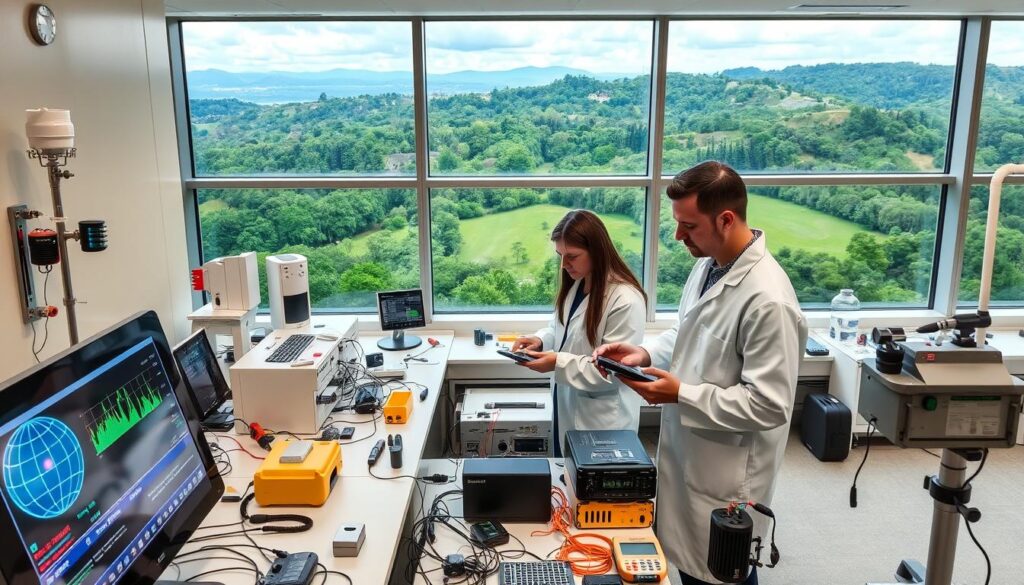
Despite significant advancements in environmental monitoring technologies, the field continues to face numerous challenges. Environmental monitoring is crucial for understanding and mitigating the impact of human activities on the environment. However, several factors complicate this endeavor.
Funding and Resource Limitations
One of the primary challenges in environmental monitoring is the limitation of funding and resources. Many environmental monitoring projects are underfunded, which can limit the scope and scale of monitoring efforts. According to a study published on Frontiers in Environmental Science, securing adequate funding is a persistent issue that affects the sustainability of environmental monitoring projects.
To address funding limitations, it’s essential to explore alternative funding sources and to prioritize monitoring efforts based on environmental risk and potential impact.
Technological Limitations
Technological limitations also pose a significant challenge. While remote monitoring solutions have advanced considerably, there are still areas where technology is lacking or not sufficiently robust for long-term monitoring. For instance, in remote or hard-to-reach areas, the deployment and maintenance of monitoring equipment can be particularly challenging.
Data Interpretation Difficulties
Another challenge is the interpretation of the data collected through environmental monitoring. The vast amounts of data generated by modern monitoring systems can be overwhelming, and extracting meaningful insights requires sophisticated data analysis techniques. Moreover, the accuracy of the data is paramount; inaccurate data can lead to misguided decisions.
Potential Solutions and Future Directions
To overcome these challenges, it’s crucial to invest in research and development to improve monitoring technologies and data analysis techniques. Collaboration between government agencies, private sector entities, and academic institutions can also help in leveraging resources and expertise.
| Challenge | Description | Potential Solution |
|---|---|---|
| Funding Limitations | Insufficient funds for monitoring projects | Explore alternative funding sources |
| Technological Limitations | Lack of robust technology for certain environments | Invest in R&D for monitoring technologies |
| Data Interpretation | Difficulty in analyzing large datasets | Develop advanced data analysis techniques |
Case Studies: Successful Environmental Monitoring Projects
Successful environmental monitoring projects have been conducted across the globe, showcasing the power of environmental sensors and data analysis. These projects have demonstrated significant improvements in environmental health and sustainability.
Urban Air Quality Studies
In urban areas, air quality monitoring has become crucial due to increasing pollution levels. Environmental sensors are deployed to measure pollutants such as NO2, SO2, and particulate matter. For instance, a project in Los Angeles utilized a network of sensors to monitor air quality, providing real-time data that helped in policy-making and reducing emissions.
| City | Pollutant Monitored | Outcome |
|---|---|---|
| Los Angeles | NO2, SO2, Particulate Matter | Reduced emissions through informed policy |
| New York | CO, O3 | Improved air quality indexes |
Water Monitoring in Agricultural Areas
Agricultural runoff is a significant source of water pollution. Environmental monitoring projects in agricultural areas focus on tracking nutrient runoff and water quality. For example, a project in Iowa used data analysis to understand the impact of fertilizer use on local water bodies, leading to more sustainable farming practices.
- Monitoring nutrient levels
- Assessing water quality
- Promoting sustainable agricultural practices
Soil Remediation Projects
Soil remediation is critical for restoring contaminated land. Projects have used environmental sensors to monitor soil health and detect contaminants. A case study in a polluted industrial site demonstrated the effectiveness of using sensor data to guide remediation efforts, resulting in the successful restoration of the site.
These case studies highlight the importance of data analysis and environmental sensors in successful environmental monitoring projects. By leveraging these technologies, communities can better understand and mitigate environmental challenges.
Community Involvement and Public Participation
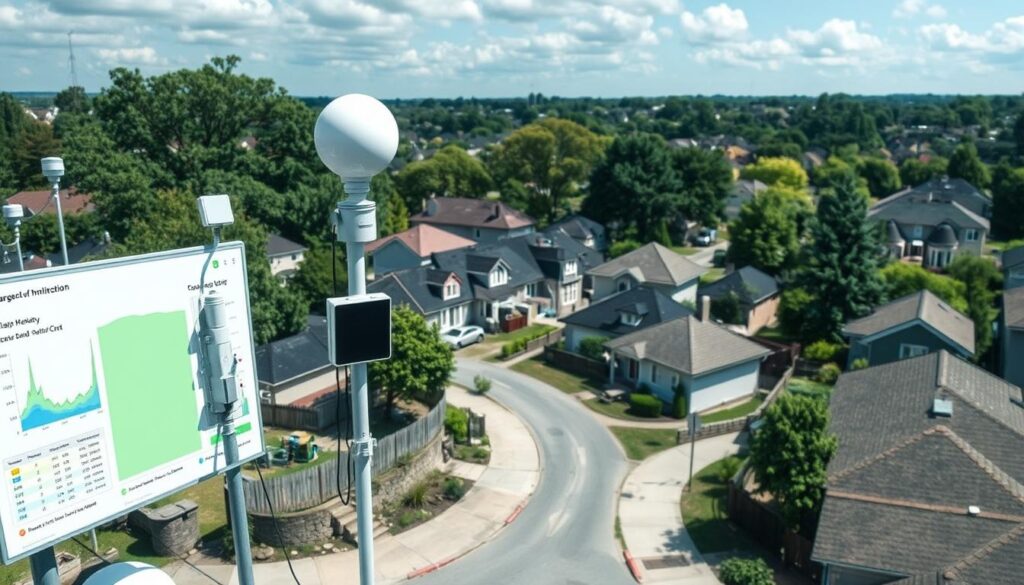
Environmental monitoring benefits greatly from active community involvement and public participation. By engaging local communities, environmental engineers can promote environmental awareness and encourage the adoption of sustainable practices.
Engaging Local Communities
Engaging local communities is a critical step in environmental monitoring. It involves educating the public about the importance of environmental monitoring and encouraging their participation in data collection and other related activities. Community-based monitoring programs can provide valuable insights into local environmental conditions and help identify potential issues early on.
Citizen Science Initiatives
Citizen science initiatives have gained popularity in recent years as a means of involving the public in environmental monitoring. These initiatives empower citizens to contribute to scientific research and data collection, often through the use of low-cost, real-time monitoring technologies. By participating in citizen science projects, individuals can gain a deeper understanding of environmental issues and develop a sense of ownership in environmental conservation efforts.
Educational Programs
Educational programs play a vital role in promoting environmental awareness and fostering a culture of sustainability. By incorporating environmental education into school curricula and offering community workshops, we can equip individuals with the knowledge and skills needed to participate in environmental monitoring and conservation efforts. Environmental education programs can also inspire future generations to pursue careers in environmental science and engineering.
In conclusion, community involvement and public participation are essential components of effective environmental monitoring. By engaging local communities, promoting citizen science initiatives, and supporting educational programs, we can create a more informed and active public that is better equipped to address environmental challenges.
The Role of Engineers in Environmental Monitoring
Environmental engineers are at the forefront of monitoring and preserving environmental health, requiring a diverse set of skills. Their role is multifaceted, involving the design, implementation, and maintenance of systems that monitor environmental conditions.
Skill Sets Required
Engineers in environmental monitoring must possess a strong foundation in technical skills, including proficiency in sensor technology and data analysis software. They must also be adept at problem-solving and able to interpret complex data sets to inform environmental policies.
“The integration of advanced technologies, such as remote sensing and GIS, has revolutionized the field of environmental monitoring,” notes an expert in the field. “Engineers must stay abreast of these developments to effectively monitor and mitigate environmental impacts.”
Interdisciplinary Collaboration
Effective environmental monitoring requires collaboration across multiple disciplines. Engineers work alongside ecologists, policymakers, and other stakeholders to ensure that monitoring efforts are comprehensive and address the needs of various stakeholders.
- Collaboration with ecologists to understand the biological impacts of environmental changes
- Working with policymakers to develop regulations based on monitoring data
- Engaging with local communities to raise awareness and involve them in monitoring efforts
Ethical Responsibilities
Engineers in environmental monitoring have ethical responsibilities to ensure that their work is conducted with integrity and transparency. This includes being mindful of the potential environmental and social impacts of their projects.
“As environmental engineers, we have a duty to protect the environment and public health. This requires not only technical competence but also a commitment to ethical practice.”
By combining technical expertise with interdisciplinary collaboration and a strong ethical foundation, environmental engineers play a crucial role in safeguarding the health of our planet.
Future Trends in Environmental Monitoring Engineering
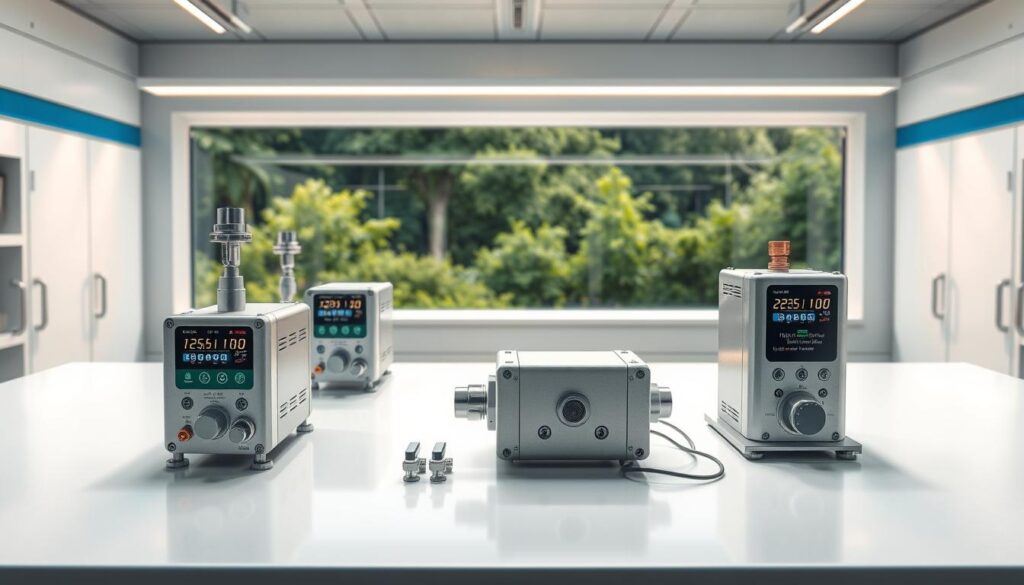
Emerging trends in sensor technology, AI, and global collaborations are set to redefine environmental monitoring engineering. These advancements are crucial for enhancing remote monitoring solutions and improving environmental data collection.
Advancements in Sensor Technology
The development of more sophisticated sensors is revolutionizing the field. These sensors offer higher precision and the ability to monitor a wider range of environmental parameters in real-time.
Miniaturization and increased durability are key trends in sensor technology, enabling deployment in previously inaccessible locations. This advancement is crucial for comprehensive environmental monitoring.
Increased Use of AI and Machine Learning
AI and machine learning are transforming environmental data analysis. These technologies enable the processing of vast datasets to identify patterns and predict future environmental changes.
- Enhanced predictive modeling
- Automated anomaly detection
- Optimized data collection strategies
The integration of AI and machine learning into environmental monitoring systems is a significant step forward, allowing for more informed decision-making.
Global Collaborations
Global collaborations are essential for addressing the global nature of environmental challenges. By sharing data and resources, countries can work together more effectively to monitor and mitigate environmental issues.
Examples include international agreements on climate change and collaborative research initiatives. These collaborations facilitate the development of standardized monitoring protocols and the sharing of best practices.
As environmental monitoring engineering continues to evolve, the importance of global cooperation cannot be overstated. It is through these collaborations that we can hope to address the complex, interconnected challenges facing our planet.
Importance of Continuous Monitoring
The significance of continuous monitoring in environmental engineering cannot be overstated, as it informs policy development and ensures long-term environmental health. Continuous monitoring enables environmental engineers to track changes in environmental pollutants, providing critical data for analysis and decision-making.
Continuous monitoring systems are vital for assessing environmental quality and detecting potential issues before they escalate. By leveraging advanced environmental monitoring systems, engineers can gather real-time data, facilitating prompt interventions.
Impact on Policy Development
Continuous monitoring has a profound impact on policy development. By providing accurate and timely data, it enables policymakers to make informed decisions. For instance, data analysis from continuous monitoring can highlight areas that require regulatory attention, thus shaping environmental policies. As noted in various studies, the integration of data from continuous monitoring into policy frameworks is crucial for effective environmental governance.
- Identifies trends and patterns in environmental data
- Informs the development of targeted environmental regulations
- Supports the evaluation of policy effectiveness over time
Moreover, the use of continuous monitoring data in policy development is becoming increasingly sophisticated, with engineers utilizing advanced data analysis techniques to predict future environmental scenarios and recommend preemptive measures.
Long-Term Environmental Health
In addition to influencing policy, continuous monitoring is essential for maintaining long-term environmental health. It allows for the early detection of environmental hazards, enabling swift action to mitigate their impact. Continuous monitoring also facilitates the assessment of long-term trends in environmental quality, helping to identify areas that require sustained attention.
By ensuring that environmental monitoring is an ongoing process, we can better understand the dynamics of environmental systems and make more effective decisions to protect them. This ongoing commitment to monitoring is crucial for achieving sustainable environmental management and ensuring the health of our planet for future generations.
Environmental Monitoring in Disaster Response
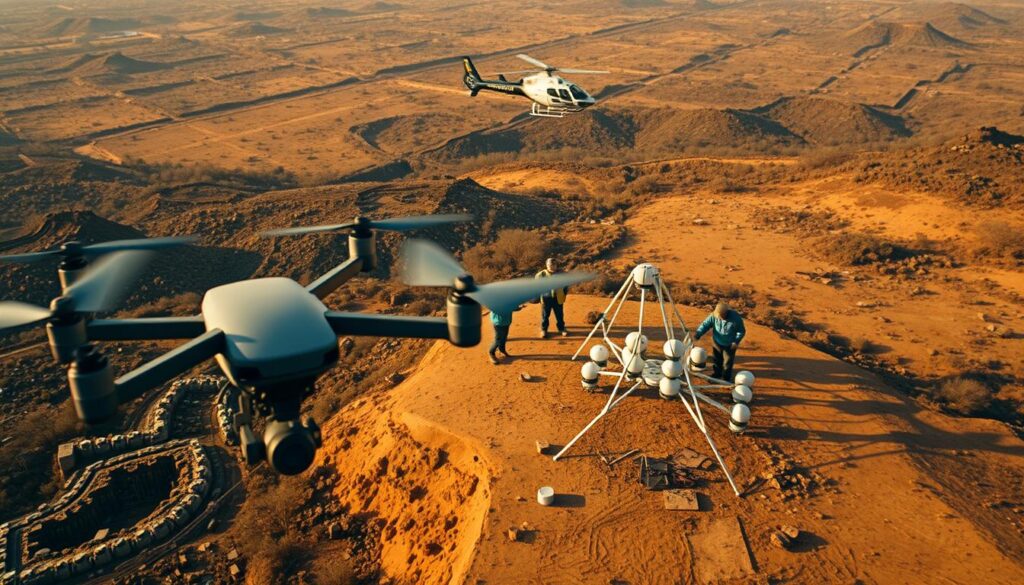
The importance of environmental monitoring in disaster response cannot be overstated, as it facilitates rapid and informed decision-making. Environmental engineers rely on environmental sensors and real-time monitoring systems to assess and respond to natural disasters effectively.
During natural disasters, environmental monitoring plays a critical role in providing timely data. This data is crucial for assessing the situation, planning response efforts, and mitigating the disaster’s impact. For instance, real-time monitoring of weather conditions, water levels, and air quality helps emergency responders make informed decisions.
Role during Natural Disasters
Environmental monitoring systems are vital during natural disasters such as hurricanes, floods, and wildfires. They provide critical data that helps in understanding the severity of the disaster and in planning relief efforts. According to experts at Ignitec, effective environmental monitoring can significantly reduce the impact of such disasters.
- Monitoring weather conditions to predict the path and intensity of storms.
- Assessing water quality to ensure safe drinking water and to identify potential flood risks.
- Tracking air quality to protect both responders and the affected population from hazardous conditions.
Long-Term Monitoring After Events
After a natural disaster, long-term environmental monitoring is essential for assessing the recovery process and ensuring that the environment is returning to a safe state. This involves continued monitoring of air and water quality, soil conditions, and biodiversity. Long-term data helps in understanding the environmental impact of the disaster and in planning reconstruction efforts.
For example, after a wildfire, monitoring soil erosion and water quality can help prevent further environmental degradation. Similarly, tracking the recovery of local ecosystems can inform conservation efforts and ensure that the affected areas are restored effectively.
The Impact of Climate Change
Climate change is one of the most pressing issues of our time, with far-reaching consequences for environmental monitoring engineering. As global temperatures rise, the frequency and severity of weather events increase, and ecosystems are disrupted, the need for effective environmental monitoring becomes more critical.
The effects of climate change are widespread, impacting air and water quality, soil health, and biodiversity. Environmental engineers must develop and implement robust monitoring systems to track these changes and inform adaptation and mitigation strategies.
Monitoring Climate Change Effects
Monitoring the effects of climate change requires a multi-faceted approach, incorporating various technologies and methodologies. Sensor technology plays a crucial role in this endeavor, enabling the collection of real-time data on environmental parameters such as temperature, humidity, and air quality.
Remote sensing technologies, including satellite imagery, provide valuable insights into large-scale environmental changes, such as deforestation and glacier melting. In-situ measurement tools, on the other hand, offer detailed information on local conditions, helping to identify areas most vulnerable to climate change impacts.
Adaptation Strategies
Developing effective adaptation strategies is essential for mitigating the impacts of climate change. This involves not only understanding the current and projected effects of climate change but also engaging with communities and stakeholders to develop resilient solutions.
Environmental engineers can contribute to adaptation efforts by designing infrastructure that accounts for projected climate changes, such as sea-level rise and increased precipitation. Additionally, they can develop early warning systems for extreme weather events, helping to protect communities and ecosystems.
By combining advanced monitoring technologies with robust data analysis and community engagement, environmental engineers can play a pivotal role in addressing the challenges posed by climate change.
Professional Organizations and Resources
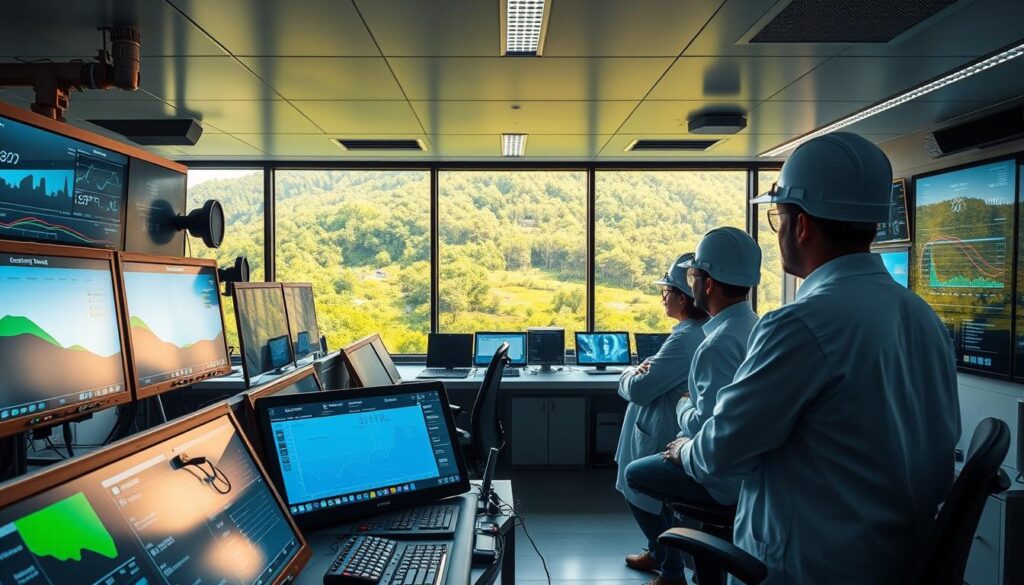
The importance of professional organizations in environmental engineering cannot be overstated, as they provide crucial resources and networking opportunities. These organizations support environmental engineers by offering access to the latest technologies, educational materials, and training programs.
Key Associations in Environmental Engineering
Several key associations play a significant role in environmental engineering. The American Society of Civil Engineers (ASCE) is one such organization that provides resources, including publications and conferences, focused on environmental engineering. Another notable association is the Environmental and Water Resources Institute (EWRI), which offers continuing education opportunities and access to technical resources.
These organizations often collaborate on projects, share knowledge, and advocate for policies that support environmental sustainability. For instance, the ASCE has been involved in various initiatives aimed at improving environmental monitoring systems, which are critical for assessing and mitigating the impact of human activities on the environment.
“The future of environmental engineering depends on our ability to harness technology and collaboration to address the complex challenges we face,” said an ASCE representative.
Educational Resources and Training Programs
Professional organizations also provide a wealth of educational resources and training programs tailored to environmental engineers. These resources include online courses, workshops, and certification programs designed to enhance skills in areas such as data analysis, a critical component of environmental monitoring.
For example, the EWRI offers training programs that focus on the latest methodologies in water resources management, which is an essential aspect of environmental engineering. These programs help professionals stay updated on best practices and emerging technologies.
- Certification programs in environmental engineering
- Workshops on advanced data analysis techniques
- Online courses on environmental monitoring systems
By leveraging these resources, environmental engineers can enhance their expertise and contribute more effectively to projects that involve complex data analysis and environmental monitoring systems.
Funding Opportunities for Environmental Projects
Funding is the backbone of environmental projects, with opportunities arising from government initiatives and private investments in remote monitoring solutions. The success of these projects heavily relies on securing financial support from various sources.
Environmental monitoring engineering projects, in particular, require substantial funding to implement and maintain. These funds are crucial for the development and deployment of technologies that monitor environmental conditions.
Government Grants and Finances
Government grants play a significant role in funding environmental projects. These grants are often allocated based on the project’s potential impact on environmental conservation and sustainability. For instance, the Environmental Protection Agency (EPA) offers various grants for projects related to air and water quality monitoring.
- Clean Water State Revolving Fund (CWSRF) for water quality projects
- State and Tribal Assistance Grants for various environmental projects
- EPA’s Environmental Education Grants for educational initiatives
Private Sector Contributions
The private sector also contributes significantly to environmental project funding through corporate social responsibility (CSR) initiatives and investments in environmental monitoring engineering. Companies may sponsor specific projects or provide funding for research and development in remote monitoring technologies.
Examples include:
- Corporate sponsorships for environmental conservation projects
- Private investments in green technologies
- Partnerships between private companies and government agencies for large-scale environmental projects
In conclusion, a combination of government grants and private sector contributions is vital for the funding of environmental projects. By exploring these opportunities, project initiators can secure the necessary financial support to advance their initiatives in remote monitoring solutions and contribute to a more sustainable future.
Conclusion: The Future of Environmental Monitoring
As we look to the future, environmental monitoring engineering is poised to play a critical role in protecting our planet. Advances in environmental sensors and environmental data collection are driving this progress, enabling more accurate and comprehensive monitoring of our environment.
Key Takeaways
The importance of environmental monitoring cannot be overstated. From regulatory compliance to community engagement, the field encompasses a broad range of activities. Technologies such as remote sensing and in-situ measurement tools have revolutionized data collection, while Geographic Information Systems (GIS) have enhanced data analysis.
Advancing the Field
For environmental engineers, the path forward involves leveraging these advancements to improve environmental outcomes. By developing and deploying more sophisticated environmental sensors, enhancing environmental data collection methods, and applying cutting-edge data analysis techniques, engineers can help address pressing environmental challenges. As the field continues to evolve, collaboration and innovation will be key to achieving a more sustainable future.
